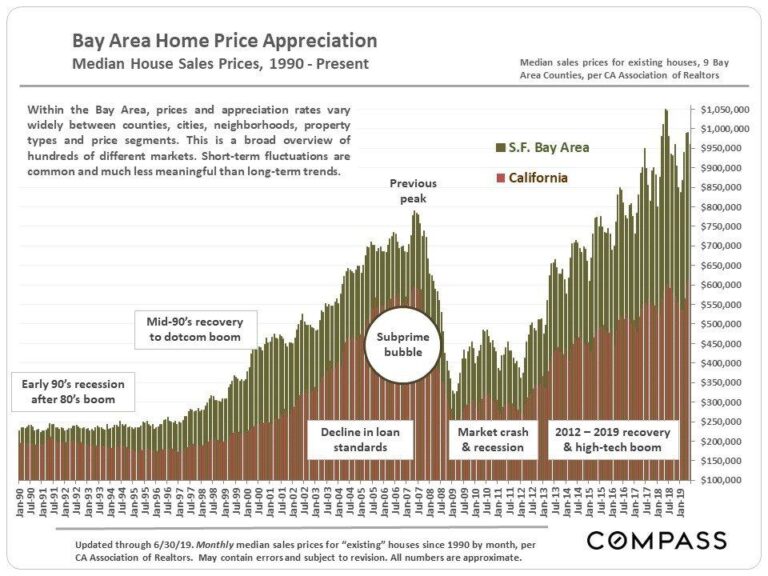San Francisco, once a beacon of opportunity and innovation, has become increasingly out of reach for ordinary residents seeking to own a home. Skyrocketing property prices and mounting economic pressures have transformed the cityŌĆÖs housing market into one of the most expensive in the nation. This article explores the complex factors that have contributed to San FranciscoŌĆÖs affordability crisis, examining how shifts in policy, the tech boom, and market dynamics collided to push homeownership beyond the grasp of many longtime inhabitants.
Housing Crisis in San Francisco Deepens as Prices Soar Beyond Reach
San Francisco’s housing market continues to spiral out of reach for the average resident, with median home prices now exceeding $1.5 million. Despite steady wage growth, the cost of living and property prices have far outpaced income, pushing many into precarious living situations. Key factors contributing to this crisis include:
- Limited new construction: Strict zoning laws and community opposition have curtailed the expansion of affordable housing projects.
- Surging demand: The city’s booming tech industry has attracted high earners, intensifying competition for limited properties.
- Investment pressures: Increased purchases by investors have driven prices upward, reducing inventory for first-time buyers.
| Year | Median Home Price | Median Household Income | Price-to-Income Ratio |
|---|---|---|---|
| 2015 | $950,000 | $110,000 | 8.6 |
| 2020 | $1,250,000 | $130,000 | 9.6 |
| 2024 | $1,520,000 | $140,000 | 10.9 |
Efforts to address the crisis face significant hurdles. Proposed reforms aimed at easing restrictions on new developments have met political resistance and community backlash. Meanwhile, affordable housing initiatives remain underfunded and insufficient to meet the growing demand. Without decisive policy changes, the gap between earning capacity and housing costs is expected to widen, further marginalizing long-term residents and exacerbating homelessness across the city.
The Role of Tech Industry Growth and Limited Housing Supply in Driving Costs
The meteoric rise of San FranciscoŌĆÖs tech industry has created an economic boom, but it has also intensified the housing crisis, pushing average home prices well beyond the reach of ordinary residents. Major tech firms, drawing thousands of highly compensated workers, have driven demand for local housing to unprecedented levels. This surge in demand, juxtaposed with a chronic shortage of available homes, has created a fierce competitive environment that favors wealthy buyers, often leaving long-time locals priced out. The influx of tech professionals has transformed neighborhoods, sparking rapid gentrification and escalating rents in traditionally affordable areas.
Contributing to this affordability crisis is the city’s limited housing stock, constrained by strict zoning laws, environmental regulations, and community resistance to new developments. Building approvals are notoriously slow, and the scarcity of developable land within city limits compounds the problem. Below is a quick overview of factors influencing housing availability and market prices:
| Factor | Impact on Housing |
|---|---|
| Zoning Restrictions | Limits on density reduce new housing supply |
| Environmental Regulations | Lengthy permit processes delay construction |
| Community Opposition | “Not In My Backyard” attitudes hinder new builds |
| Tech Industry Employment Growth | High-income buyers increase competition |
Impact on Working Families and the Erosion of Community Diversity
Skyrocketing housing prices have devastated working families in San Francisco, pushing many to the brink of displacement. Jobs that once supported modest, stable households are no longer sufficient to cover rent, let alone homeownership. The resulting financial strain forces families into cramped living conditions or long commutes, eroding quality of life and economic mobility. This widening affordability gap aggravates socio-economic inequalities, as those earning moderate incomes are systematically priced out of neighborhoods close to their workplaces and essential services.
The consequences extend beyond individual families, shaking the very fabric of community diversity. Historically eclectic neighborhoods, once vibrant with a mosaic of cultures and incomes, are becoming homogenized enclaves for the affluent. This transformation diminishes cultural exchange and the rich diversity that has defined San FranciscoŌĆÖs character for decades. Key impacts include:
- Loss of small, family-owned businesses catering to a diverse clientele
- Declining ethnic and economic diversity within schools and neighborhoods
- Increase in social isolation for displaced or marginalized populations
- Reduced civic engagement and neighborhood cohesion
| Community Factor | Before Housing Crisis | Now |
|---|---|---|
| Neighborhood Diversity | High | Significantly Reduced |
| Working-Class Families | Strong Presence | Nearly Absent |
| Local Businesses | Thriving | Declining |
| Affordable Housing Units | Adequate | Insufficient |
Policy Solutions and Innovative Approaches to Restore Housing Affordability
Addressing the housing crisis in San Francisco requires a multi-faceted strategy that balances immediate relief with long-term transformation. City planners and policymakers are increasingly advocating for upzoning existing neighborhoods, allowing for taller buildings and higher density. This change aims to increase supply without compromising community character. Simultaneously, innovative financing models, such as community land trusts and shared equity programs, provide pathways for low- and middle-income residents to build equity while keeping homes affordable. These approaches, championed by housing advocates, serve as crucial counterweights to rampant speculation and investment-driven price hikes.
Additional policy tools gaining traction include:
- Inclusionary zoning mandates requiring developers to allocate a percentage of new units for affordable housing
- Streamlining permit processes to reduce construction delays and costs
- Public-private partnerships that incentivize mixed-income developments
- Rent stabilization enhancements designed to protect existing tenants from displacement
| Policy Initiative | Impact Potential | Status |
|---|---|---|
| Upzoning Residential Zones | High ŌĆō Increases housing stock rapidly | Pilot Implemented |
| Community Land Trusts | Moderate ŌĆō Ensures long-term affordability | Expanding |
| Inclusionary Zoning | Moderate ŌĆō Creates mixed-income communities | Ongoing |
| Streamlined Permitting | High ŌĆō Reduces time & costs | Under Review |
In Conclusion
As San FranciscoŌĆÖs housing crisis deepens, the dream of homeownership drifts further out of reach for ordinary residents. This complex issue, shaped by decades of policy decisions, economic shifts, and market forces, underscores the urgent need for thoughtful, inclusive solutions. Understanding how the city arrived at this precarious point is essentialŌĆönot only for San Francisco but also for other urban areas facing similar challengesŌĆöif meaningful change is to be realized.




